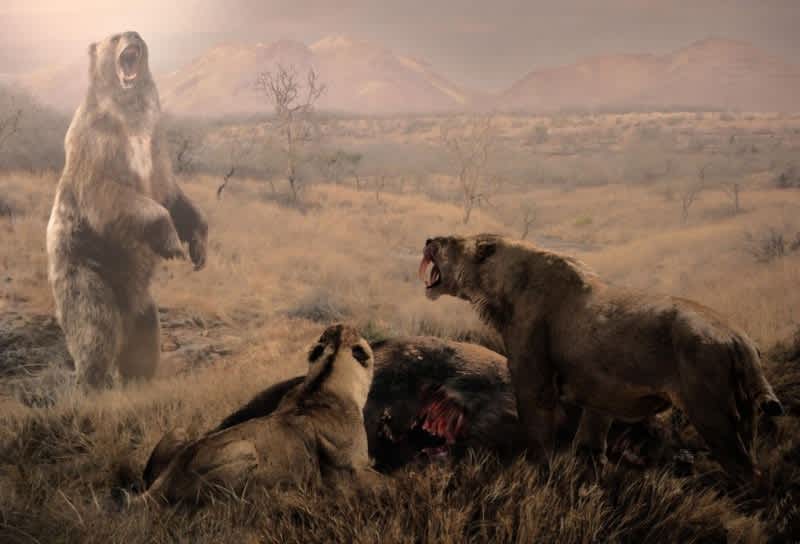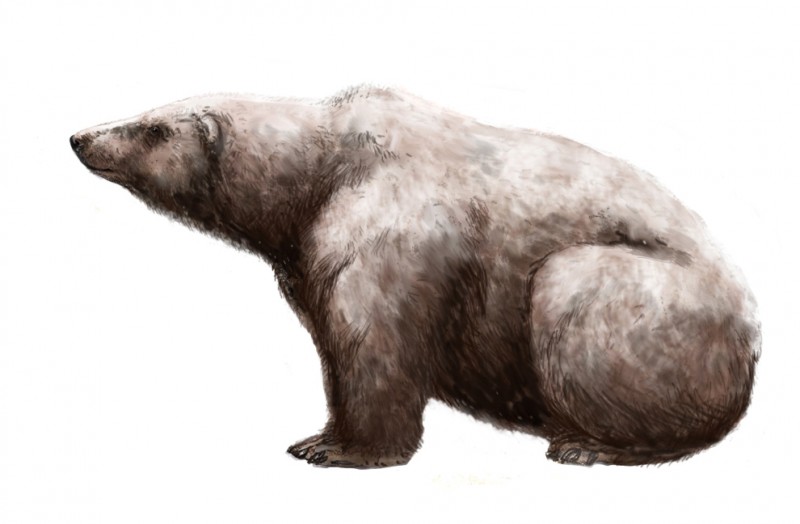5 Prehistoric Bear Species That Dwarf Modern Bears
OutdoorHub Reporters 11.02.15

Compared to prehistoric bear species, modern bears are relatively tame. Then again, today’s bruins don’t have to carve out territory from other terrifying predators such as saber-toothed cats, packs of dire wolves, cave lions, and even massive carnivorous, cow-sized pigs that were more likely to charge you—and eat you—then run away.
Ancient bears did all that and what’s more, they were usually the strongest of the strong. Other predators might be quicker or even smarter, but beyond the dinosaurs, few land predators could boast to be as powerful as a bear.
Here is our list of five ancient, extinct bear species that would give modern bears a run of their money. Much like our list of massive ancient deer however, it goes to show that after the ice age, size actually ended up being a disadvantage. The bears on this list either evolved into a smaller version, or simply died out altogether.
Could you imagine taking on one of these beasts during bear season? That .450 Marlin may no longer cut it.
1. History’s largest bear (Arctotherium angustidens)

This is quite simply, the largest bear ever discovered and by default, a contender for the largest carnivorous land mammal ever to live. The Arctotherium angustidens was isolated primarily to South America during the Pleistocene epoch 2.5 million to 11,000 years ago. This bear was so massive that scientists believe it regularly weighed between 2,000 and 4,000 pounds, although newer estimates have brought down the upper end of that scale to around 3,500 pounds. Still, that meant that these huge ancient bears outweighed their largest modern equivalents—Kodiak and polar bears—by a significant margin. The Arctotherium’s closest living relative, spectacled bears, only weighs less than a ninth of these behemoths.
When standing on its hind legs, the angustidens measured about as tall as the largest modern bears, but its true power lay in the robust construction of its body. Heavily muscled and far stouter than today’s bears, the angustidens was a predator unlike any other. It often challenged the other apex predators of its day, such as saber-toothed cats, and won. As for its diet, it routinely ate other megafauna such as giant armadillos, ancient toxodons, and even camels.
Unfortunately, its large bulk was also its main liability. The angustidens sound found itself outnumbered and outclassed by smaller, swifter predators such as the jaguar. These more mobile predators soon dominated predatory niches once occupied by the bear, and the species adapted by becoming smaller and quicker itself. It survives into the modern day as the spectacled bear, which remains the largest predator in South America, but only a pale shadow of the powerful carnivore it once was.
You can see a massive bear from the Arctotherium genus take on two saber-toothed cats in this artist’s depiction:
First time on Twitter: Arctotherium bonariense is interested in the dinner of a couple of Similodon populator pic.twitter.com/HYZjvxNmEc
— Velizar Simeonovski (@VelizarSim) February 23, 2014
2. The cave bear (Ursus spelaeus)

Existing in Europe during the Pleistocene and only becoming extinct 24,000 years ago, the cave bear was one of the largest bears to have ever called Europe home. Early researchers initially mistook fossils of these ancient bruins for polar bears, but subsequent investigation revealed a species related to the modern brown bear, albeit with broader skulls, longer thighs, and robust shins. Cave bears are about as large as the biggest modern bears.
The characteristic that set cave bears apart from other bruins is of course, their tendency to live in caves year round. Unlike other bears, who only stay in caves briefly during hibernation, the spelaeus spend most of their time inside the limestone caves of Western Europe. In parts of Russia, where the bears frequently interacted with cave lions, the two apex predators battled constantly for territory. Both bears and lions would occasionally prey on each others’ young, and sometimes researchers would discover their skeletons intermixed in the same cave. Naturally, the winner of these fierce battles would also claim the cave for themselves.
3. The giant short-faced bear (Arctodus simus)

Genetically very similar to the Arctotherium genus, the giant short-faced bear is one of the few species that dared to rival the Arctotherium in size as well. The species first appeared roughly 800,000 years ago in what is now the United States, and soon spread in Canada. It is believed that the bear averaged 2,000 pounds and stood six foot tall at the shoulder. Fully drawn up, these massive bears could reach up to 12 feet.
Like the Arctotherium, the short-faced bear’s size worked against it. Scientists believed at first that the bear simply overwhelmed any prey it found, but it was eventually found that the bear’s poor turning ability made it a subpar ambush predator. Instead, new theories suggest that the bear would plod along after its prey, much like a human persistence hunter, and wear it down with superior endurance. Other researchers say the bear likely bullied other predators and forced them to give up their catches as well.
You can see a video recreation of this bear below:
4. The king polar bear (Ursus maritimus tyrannus)

Imagine the largest polar bear you’ve ever seen on TV (or in real life). Now imagine that being bigger. Very little is known about this ancient species of polar bear, but what is known is from a single fragmentary ulna discovered near London. It is believed that the species appeared 130,000 years ago and provided the evolutionary link between grizzly bears and modern polar bears.
Maybe. Due to the lack of a complete skeleton or other collaborating evidence, scientists can only guess at what role this bear had.
The king polar bear is believed to have the bone structure of a grizzly bear and the arctic adaptations of the polar bear. As one of the largest bear species, it often took on large prey such as buffalo or even young mammoths, but scientists believe that like most large bear species, the tyrannus primarily forced other predators off their own meals.
5. The bear with the crushing bite (Agriotherium africanum)

This bear is not all that special at first glance. It’s about as large as a modern grizzly, and except for the raccoon-like pattern on its face, it looks much like a grizzly as well. Yet one look at the skull of an africanum will tell a different story, as will a peek at its teeth. The africanum has the strongest bite of any bear, extinct or living, and it could crush straight through almost anything. Scientists believe that the bear evolved for this trait to handle the stress of struggling prey on its teeth, but over time the africanum found itself capable of crushing bone and muscle, making going for the vitals only a formality.
When this powerful bear was not hunting for itself, it munched through carrion and used its specialized jaw to severe off entire parts of prey to save for later. Scientists believe the africanum was a big fan of plants too, and this theory came from the fact that of all modern bear species, the giant panda has the greatest bite force for its size. Just like pandas, the ancient africanum may have used its oversized teeth to chew through hard plants. It is believed to have lived during the Miocene and was found across the world.

